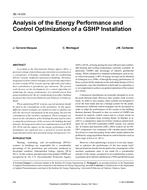According to the International Energy Agency (IEA), a great percentage of greenhouse gas emissions are produced as a consequence of heating, ventilating, and air-conditioning (HVAC) systems’ inefficient operation in buildings. Therefore, integrated-system control strategies are of extreme importance in order to make HVAC systems operate efficiently and reduce their contribution to greenhouse gas emissions. The present work focuses on the development of a control algorithm for optimizing the energy performance of a ground-source heat pump installation for the air conditioning of an office building located at the Universitat Politècnica deValència, inValencia, Spain.
When optimizing HVAC systems, special attention should be paid to the consumption of the auxiliaries. In this paper, different control strategies are studied in order to optimize not only the electrical consumption of the heat pump, but also the consumption of the auxiliary equipment. These strategies are based on the calculation of the building thermal load in order to adapt the performance of the system to the building thermal demand. An integrated control was implemented in LabVIEW (NI 2014) and the impact on the energy performance of the installation was analyzed over a period of several months. Experimental results show potential energy savings up to 21%.
Citation: ASHRAE Transactions – Volume 120, Part 2, Seattle, WA
Product Details
- Published:
- 2014
- Number of Pages:
- 14
- File Size:
- 1 file , 4.3 MB
- Product Code(s):
- D-SE-14-030
